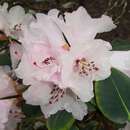Description
provided by eFloras
Shrubs or small trees 2–4 m tall; older branches grayish, bark falling off in flakes; branchlets 4–5 mm in diam. below inflorescence; young shoots greenish, glabrous. Petiole often slightly winged, 20–30 × 3–4 mm; leaf blade leathery, broadly elliptic to suborbicular, 8–13 × 5–9 cm; base rounded; margin reflexed; apex apiculate; abaxial surface glaucous, glabrous or with a few scattered hairs; adaxial surface deep green, glabrous; midrib flat adaxially; lateral veins 11–14-paired, slightly impressed on both surfaces. Inflorescence 5–9-flowered; rachis 8–15 mm, pubescent or glabrous. Pedicel 1–2 cm, glabrous; calyx pale pink, cupular, fleshy; lobes 5, 7–12 mm, glabrous; corolla campanulate or funnel-campanulate, fleshy, creamy-white to clear pink, flecks lacking, 5–6 cm, base with dark nectar pouches; lobes 5, rounded, ca. 1.5 × 2.3 cm, emarginate; stamens 10, unequal, 2–4 cm, filaments glabrous; ovary conical 6–7 mm, glabrous or with a few glands; style 2.5–3 cm, glabrous. Capsule oblong, blunt, 12–20 × 7–10 mm, glaucous, base usually enclosed by persistent calyx. Fl. Apr–May, fr. Aug–Oct.
- license
- cc-by-nc-sa-3.0
- copyright
- Missouri Botanical Garden, 4344 Shaw Boulevard, St. Louis, MO, 63110 USA
Habitat
provided by eFloras
Pinus forest margins, Rhododendron thickets; 3000–4000 m.
- license
- cc-by-nc-sa-3.0
- copyright
- Missouri Botanical Garden, 4344 Shaw Boulevard, St. Louis, MO, 63110 USA
Rhododendron cyanocarpum: Brief Summary
provided by wikipedia EN
Rhododendron cyanocarpum is an evergreen shrub or small tree with leathery leaves and fragrant white or pink tinged flowers that are bell or funnel shaped. It is endemic to China (Sichuan and Yunnan) where it grows at altitudes of 3,000–4,000 m (9,800–13,100 ft). It is threatened by habitat loss.
It was originally discovered by Père Jean Marie Delavay, but later introduced to western horticulture by the Scottish botanist George Forrest in 1902.
- license
- cc-by-sa-3.0
- copyright
- Wikipedia authors and editors

